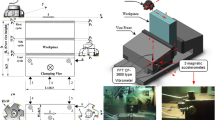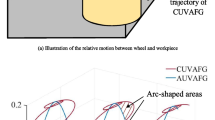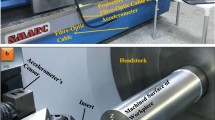Abstract
This paper studies the influence of radial depth on vibration, chip formation and surface roughness during face milling of AISI304 austenitic stainless steel with indexable cemented carbide milling cutters. The amplitude of vibration acceleration increased with the increasing radial depth up to 80 mm. And the domain vibration frequency varied with the radial depth. In this paper, three types of chips were found: C shape, long shape and spiral shape. The minimum surface roughness value occurred when the radial depth equalled 40 mm in the experiment. Irregular changes of chip curl radius and chip thickness could be attributed to different numbers of alternately engaged teeth when the feed and speed were fixed. Surface roughness is related to forced vibration and chip formation. Radial depth with different numbers of alternately engaged teeth could significantly influence the forced vibration, chip formation, and surface roughness.
Similar content being viewed by others
References
Nalbant Muammer, Yildiz Yakup. Effect of cryogenic cool ing in milling process of AISI 304 stainless steel[J]. Transactions of Nonferrous Metals Society of China, 2011, 21(1): 72–79.
Ciftci Ibrahim. Machining of austenitic stainless steels using CVD multi-layer coated cemented carbide tools[J]. Tribology International, 2006, 39(6): 565–569.
Huang Chaoyu, Wang Jiunnjyh Junz. A pole/zero cancellation approach to reducing forced vibration in end milling[J]. International Journal of Machine Tools and Manufacture, 2010, 50(7): 601–610.
Lin Tsannrong. Experimental study of burr formation and tool chip** in the face milling of stainless steel[J]. Journal of Materials Processing Technology, 2000, 108(1): 12–20.
Shao H, Liu L, Qu H L. Machinability study on 3%Co-12%Cr stainless steel in milling[J]. Wear, 2007, 263(1–6): 736–744.
Lin Tsannrong. Reliability and failure of face-milling tools when cutting stainless steel[J]. Journal of Materials Processing Technology, 1998, 79(1–3): 41–46.
Liew W Y H, Ding X. Wear progression of carbide tool in low-speed end milling of stainless steel[J]. Wear, 2008, 265(1/2): 155–166.
Lin Tsannrong. Experimental design and performance analysis of TiN-coated carbide tool in face milling stainless steel[J]. Journal of Materials Processing Technology, 2002, 127(1): 1–7.
Aslan Ersan, Camuscu Necip, Birgoren Burak. Design optimization of cutting parameters when turning hardened AISI 4140 steel (63 HRC) with Al2O3 + TiCN mixed ceramic tool[J]. Materials & Design, 2007, 28(5): 1618–1622.
Biermann D, Baschin A. Influence of cutting edge geometry and cutting edge radius on the stability of micromilling process[J]. Production Engineering, 2009, 3(4/5): 375–380.
Klim Z, Ennajimi E, Balazinski M et al. Cutting tool reliability analysis for variable feed milling of 17-4PH stainless steel[J]. Wear, 1996, 195(1/2): 206–213.
Ihsan Korkut, Mustafa Kasap, Ibrahim Ciftci et al. Determination of optimum cutting parameters during machining of AISI 304 austenitic stainless steel[J]. Materials & Design, 2004, 25(4): 303–305.
Abou-El-Hossein K A, Yahya Z. High-speed end-milling of AISI 304 stainless steels using new geometrically developed carbide inserts[J]. Journal of Materials Processing Technology, 2005, 162/163: 596–602.
Zhong W W, Zhao D B, Wang X. A comparative study on dry milling and little quantity lubricant milling based on vibration signals[J]. International Journal of Machine Tools and Manufacture, 2010, 50(12): 1057–1064.
Hao Jiang, Long **nhua, Meng Guang. Study of the correlation between surface generation and cutting vibrations in peripheral milling[J]. Journal of Materials Processing Technology, 2008, 208(1–3): 229–238.
Author information
Authors and Affiliations
Corresponding author
Additional information
Supported by National Science and Technology Major Project of China(No.2009ZX04012-021) and Major State Basic Research Development Program of China (“973” Program, No.2009CB724306).
SHEN Yang, born in 1983, male, doctorate student.
Rights and permissions
About this article
Cite this article
Shen, Y., Chen, Y., Zhang, L. et al. Effect of radial depth on vibration and surface roughness during face milling of austenitic stainless steel. Trans. Tian** Univ. 17, 336–339 (2011). https://doi.org/10.1007/s12209-011-1604-6
Accepted:
Published:
Issue Date:
DOI: https://doi.org/10.1007/s12209-011-1604-6




